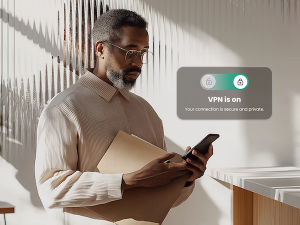“My phone’s been hacked!” These are words you never want to hear or say. Ever. You are not alone in this sentiment.
Our phones have become the central hub of our lives, storing everything from personal and financial information, access to payment apps, files, photos, and contacts. This has made our phones irresistible, prized targets for cyber criminals. And because these devices are always on and always with us, the opportunity for attack is constant. What are the signs that you have been hacked and how can you reclaim your control? This guide walks you through the common indicators of a hacked phone and what steps you can take to protect your data and privacy.
What is phone hacking and how does it work?
Phone hacking is the unauthorized access and control of your smartphone and its data. It can happen to any person and any device, whether it’s an iPhone or an Android. To achieve this, cybercriminals—also called hackers—use various types of malicious software, sometimes called malware, such as:
- Spyware, which secretly tracks your every move
- Adware, which bombards your device with pop-up ads
- Ransomware, which locks your files until you pay a fee
These attacks are typically motivated by financial gain, such as stealing banking credentials, or by a desire to monitor someone’s personal life.
The cost of phone hacking to you
Phone hacking isn’t just a technical or convenience issue. It has real and often costly consequences for your personal life, finances, and privacy. Here, we list the kinds of losses you might face with a hacked phone:
- Financial loss: Hackers can access banking apps to drain your accounts, steal credit card information for fraudulent purchases, or use your phone to subscribe to premium services without your consent.
- Identity theft: Cybercriminals can steal personal information from your device, such as your social security number, passwords, and photos—to open new accounts or commit crimes in your name.
- Severe privacy invasion: Through spyware, an attacker can turn on your phone’s camera and microphone to secretly record you, track your location in real-time, and read all your private messages.
- Emotional and reputational damage: The stress of being hacked is significant. A criminal could use your accounts to impersonate you, spread misinformation or damage your relationships with family, friends, and colleagues.
The consequences of a hacked phone go far beyond inconvenience. This is why it is so critical to stay alert for the warning signs of a compromise and know exactly what to do if your phone is hacked.
Common ways hackers gain access to your smartphone
The unfortunate reality is that anyone’s phone can be targeted and successfully hacked. Cybercriminals have developed several sophisticated methods that allow them to remotely take over your device. These tactics are done mainly by surreptitiously installing malicious software or malware, monitoring calls and messages, stealing personal information, or even taking over your various accounts. Here are detailed explanations for each hacking method:
- Malicious apps: Malware can be disguised as legitimate applications, such as games and utility tools, available on unofficial third-party app stores. Once installed, it can steal data, track your location, or install more malware. Always be cautious of apps that ask for permissions that exceed their intended function, such as a calculator app requesting access to your contacts.
- Visiting malicious websites: Visiting a compromised website on your phone could infect it with malware through a drive-by download which automatically installs malicious software, scripts that exploit your phone’s operating system vulnerabilities, or pop-ups or ads that trick you into authorizing a download, often disguised as a software update or a prize notification.
- Phishing or smishing: You might receive a text message (SMS) or email that appears to be from a trusted source, like your bank or a delivery service. These messages contain links that lead to fake websites designed to trick you into entering your passwords or personal information. A common example is a text claiming there’s a problem with a package delivery, urging you to click a link to reschedule.
- Unsecured public Wi-Fi: When you connect to a free, public Wi-Fi network at a café, airport, or hotel without protection, your data can be vulnerable. Hackers on the same network can intercept the information you send, including passwords and credit card details. Using a virtual private network (VPN) protects you on public networks.
- SIM swapping: This sophisticated scam involves a hacker impersonating you and convincing your mobile carrier to transfer your phone number to a new SIM card they control. Once they have your number, they can intercept calls and texts, including two-factor authentication codes, allowing them to take over your online accounts.
- Juice-jacking: Cybercriminals can modify public USB charging stations to install malware onto your phone while it charges. This technique can steal sensitive data from your phone. It’s always safer to use your own AC power adapter and a wall outlet.
- Outdated operating systems: Hackers actively search for security holes in older versions of iOS and Android. Installing the latest security updates for your phone’s operating system locks the doors to malware as these updates contain critical patches that protect you from newly discovered threats.
12 signs your phone was hacked
To be certain that your phone has been hacked, here are some signs you should consider. Note that these might be signs of a hacked phone, yet not always.
- More popups than usual: Phones hit with adware will be bombarded with pop-up ads. Never tap or click on them, as they might take you to pages designed to steal personal information.
- Data spikes or unknown call charges: A hacker is likely using your phone to transfer data, make purchases, send messages, or make calls via your phone.
- Issues with online accounts: Spyware might have stolen your account credentials, then transmitted them to the hacker, leading to credit and debit fraud. In some cases, hackers will change the password and lock out the device owner.
- Unexpected battery drain: Your phone’s battery dies much faster than usual because hidden malware is constantly running in the background.
- Sluggish performance: Your device freezes, crashes, or lags significantly as malicious software consumes its processing power and memory.
- Unfamiliar apps or messages: You discover apps you never installed or see outgoing calls and texts you didn’t make, indicating unauthorized use.
- Phone overheats while idle: Your device feels unusually warm even when you’re not using it, a sign of malware overworking the processor.
- Random reboots or shutdowns: The phone restarts on its own, which could be caused by conflicting malicious code or a hacker remotely controlling it.
- Camera or mic activates unexpectedly: Someone may be spying on you when the camera or microphone indicator light turns on when you aren’t using it.
- Websites look different: Pages you visit look unusual or frequently redirect you to spammy sites, indicating your web traffic is being hijacked.
- Unauthorized 2FA requests: You receive notifications for two-factor authentication codes you didn’t request, a strong signal that someone has your password and is trying to access your accounts.
- Inability to shut down properly: Your phone resists being turned off or fails to shut down completely, as malware may be designed to keep it running.
If you see several of these signs, it’s crucial to take immediate action to secure your device and data.
Clarifying misconceptions about phone hacking
Ultimately, the biggest factor in security is user behavior. Regardless of whether you use Android or iOS, practising safe habits—like avoiding suspicious links, using strong passwords, and keeping your operating system updated—is the most critical defense against having your phone hacked.
What’s easier to hack: Android or iPhone?
This is a long-standing debate, and the truth is that both platforms can be hacked. Android’s open-source nature and accommodation of third-party sources apps create more potential vulnerabilities. Additionally, security updates can sometimes be delayed depending on the device manufacturer. iPhones, while generally more secure, can be vulnerable if a user jailbreaks the device or falls victim to phishing and other social engineering scams.
Can answering a phone call get you hacked?
Simply answering a phone call cannot install malware on a modern, updated smartphone. The real danger comes from social engineering, where the caller will convince you into taking an action that compromises your security such as giving your personal information or installing something yourself. This is often called vishing or voice phishing.
Can your phone camera be hacked?
Yes, your phone’s camera and microphone can be hacked, a process known as camfecting. This is typically done using spyware hidden in malicious apps disguised as legitimate software that you may have been tricked into installing. Signs of a compromised camera include the indicator light turning on unexpectedly, finding photos or videos in your gallery that you didn’t take, or experiencing unusually high battery drain.
Can a phone be hacked when turned off?
When your phone is completely powered down, its network connections and most of its hardware are inactive, making it impossible to be actively hacked over the internet. However, some modern smartphones have features that remain active even when the device seems off, like the location tracker. Sophisticated, state-level spyware like Pegasus are also theoretically capable of attacking a device’s firmware even while turned off.
Hacking off a hacker: A step-by-step recovery guide
Sometimes you are fortunate enough to catch the hacking attempt while it is in progress, such as during a vishing incident. When this happens, you can take these immediate steps to thwart the hacker before, during and after:
- Use call screening and blocking: Enable your carrier’s spam call filtering services and manually block any suspicious numbers that call you.
- Never share one-time codes: Legitimate companies will never call you to ask for a password, PIN, or two-factor authentication (2FA) code. Treat any such request as a scam.
- Hang up and verify independently: If you receive a suspicious call, hang up immediately. Find the official phone number for the company online and call them directly.
Discovering that your phone has been hacked can be alarming, but acting quickly can help minimize the damage and restore your privacy. Here are the actions to take to regain control and protect your personal information:
- Back up essential data: Before taking any action, save your irreplaceable data such as photos, contacts, and important documents to a cloud service or computer. Do not back up applications or system data, as these may be infected.
- Disconnect immediately: The first step is to restart your phone in Safe Mode (for Android) or Recovery Mode (for iPhone). This cuts off its connection to Wi-Fi and cellular networks, preventing the hacker from sending or receiving more data.
- Run a security scan: Use a trusted mobile security app, like McAfee Mobile Security to scan your device. It’s designed to find and remove malware that may be hiding on your phone.
- Delete suspicious apps and files: Manually go through your applications and delete anything you don’t remember installing or that looks unfamiliar. Check your downloads folder for suspicious files and delete those as well.
- Clear browser cache and data: Malicious code could be stored in your browser’s cache. Go into your browser settings and clear all history, cookies, and cached data to remove lingering threats.
- Change your passwords: From a separate, uninfected device, change the passwords for your critical accounts, including email, banking, and social media. Use a password manager to create and store strong, unique passwords for each account. Enable 2FA where possible for added security.
- Secure your accounts: Review recent activity on your online accounts for any unauthorized transactions or messages. Have your bank accounts frozen and request new cards and credentials.
- Update your operating system: Check for and install the latest OS update for your device. These updates often contain critical security patches that can fix the vulnerability the hacker exploited in the first place.
- Perform a full shutdown when needed, disable always-on location features if you’re concerned.
- Perform a factory reset: If the issues persist, a factory reset is your most effective —and last—option. Once you have backed up files, resetting is a straightforward process and will completely remove any lingering malware.
- Verify backups before restoring: After cleaning your device or a factory reset, be cautious when restoring data. Ensure your backup is from a date before the hacking occurred to avoid reinfecting your phone. Restore only essential data and manually reinstall apps only from official app stores.
- Notify your contacts and authorities: Let your contacts know your phone was hacked so they can be wary of strange messages from your number. If you suspect identity theft or financial fraud, report it to the relevant authorities and your financial institutions immediately.
Future-proof your phone from hacks
- Set a SIM PIN: Add a personal identification number to your SIM card through your phone’s settings. This prevents a fraudster from using your SIM in another device to execute a SIM swap attack.
- Enable automatic security updates: Ensure your phone is set to automatically download and install OS updates. These patches often fix critical security vulnerabilities that hackers actively exploit.
- Use encrypted DNS: Enable the Private DNS feature on Android or an equivalent app on iOS to encrypt your web traffic lookups. This prevents eavesdroppers on public Wi-Fi from seeing which websites you visit.
- Disable developer options and USB debugging: These settings are for app developers and can create security backdoors if left on. Turn them off in your phone’s settings unless you have a specific need for them.
Protective measures to take in the first place
Applying security measures the moment you bring home your brand new phone helps to keep your phone from getting hacked in the first place. It only takes a few minutes. Follow these tips to find yourself much safer from the start:
- Install trusted security software immediately. You’ve adopted this good habit on your desktops and laptops. Your phones? Not so much. Online protection software gives you the first line of defense against attacks, and more.
- Go with a VPN. Make a public network safe by deploying a virtual private network, which serves as your Wi-Fi hotspot. It will encrypt your data to keep you safe from advertisers and prying eyes.
- Use a password manager. Strong, unique passwords offer another primary line of defense. Try a password manager that can create and safely store them.
- Avoid public charging stations. Look into a portable power pack that you can charge up ahead of time or run on AA batteries. They’re pretty inexpensive and are a safer alternative to public charging stations.
- Keep your eyes on your phone. Preventing the actual theft of your phone is important. This is a good case for password or PIN protecting your phone, and turning on device tracking. In case it is stolen, Apple and Google provide a step-by-step guide for remotely wiping devices.
- Stick with trusted app stores. Stick with legitimate app stores like Google Play and Apple’s App Store, which vet apps to ensure they are safe.
- Keep an eye on app permissions. Check what permissions your apps are asking for. Both iPhone and Android users can allow or revoke app permission.
- Update your phone’s operating system. Keeping your phone’s operating system up to date can fix vulnerabilities that hackers rely on to pull off attacks—it’s another tried and true method to keep your phone safe and performing well.
Advanced ways to block hackers from your phone
- Enable a SIM Card PIN: Set up a PIN for your SIM card to prevent hackers from using it in another phone for a SIM swap attack, which requires the PIN upon restart.
- Use an eSIM if possible: An embedded SIM (eSIM) cannot be physically removed from your phone, making it difficult for criminals to execute a fraudulent SIM swap.
- Enforce encrypted DNS: Configure your phone to use DNS-over-HTTPS (DoH), which encrypts your DNS queries, preventing eavesdroppers on public Wi-Fi from seeing which websites you visit.
- Deploy a hardware security key: For the ultimate 2FA protection, a physical key (like a YubiKey) for sensitive accounts makes it nearly impossible for hackers to log in without it.
- Disable USB debugging and developer mode: Unless you are an app developer, keep these advanced Android features off to close potential backdoors that malware could exploit.
- Turn off unused wireless radios: Manually disable Wi-Fi, Bluetooth, and NFC when you aren’t using them to reduce your phone’s attack surface and prevent unauthorized connections.
Stay proactive with mobile security
Protecting your phone from hackers doesn’t have to be overwhelming. By remaining vigilant for the warning signs, keeping your software updated, and using trusted security tools, you can significantly reduce your risk of getting your phone infiltrated. Think of your digital security as an ongoing practice, not a one-time fix.
Mobile security solutions like McAfee Mobile Security are specifically designed to scan your device for malware, spyware, and other malicious code. Key features to look for in a quality security app include real-time antivirus protection, web protection to block dangerous websites, and privacy monitoring to check which apps have access to your personal data. McAfee Mobile Security also offers award-winning antivirus, real-time malware scanning to stop malicious apps before they can cause harm. The included Secure VPN encrypts your connection, making public Wi-Fi safe for browsing and banking. With features like Identity Monitoring to alert you if your details are found on the dark web and Safe Browsing to block risky websites, you’re protected from multiple angles.
Be very cautious of fake anti-hack apps; these could be scams that can install malware themselves. To be safe, always download security software from reputable providers through official channels like the Google Play Store or Apple’s App Store.













